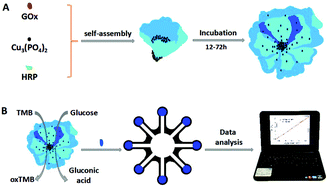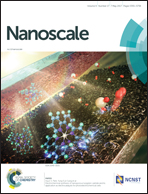A dual enzyme–inorganic hybrid nanoflower incorporated microfluidic paper-based analytic device (μPAD) biosensor for sensitive visualized detection of glucose†
Abstract
A novel microfluidic paper-based analytic device (μPAD) biosensor is developed for sensitive and visualized detection of glucose. This biosensor is easily fabricated using the wax printing technique, with a hybrid nanocomplex composed of dual enzymes glucose oxidase (GOx) and horseradish peroxidase (HRP) and Cu3(PO4)2 inorganic nanocrystals incorporated in the detection zones. The hybrid nanocomplex is found to exhibit a flower-like structure, which allows co-immobilization of these two enzymes in a biocompatible environment. These nanoflowers not only preserve the activity and enhance the stability of the enzymes, but also facilitate the transport of the substrates between the two enzymes. The biosensor is demonstrated to enable rapid and sensitive quantification of glucose in the concentration range of 0.1–10 mM with a limit of detection (LOD) of 25 μM. It is also shown to be applicable to colorimetric quantitative detection of glucose in human serum and whole blood samples, implying its potential for clinical applications.



 Please wait while we load your content...
Please wait while we load your content...